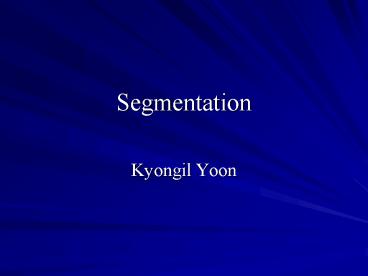Segmentation - PowerPoint PPT Presentation
1 / 11
Title:
Segmentation
Description:
Fitting lines, fitting curves. Least square. Total least square. Segmentation by fitting a model(2) ... subtraction algorithms, Joint IEEE International ... – PowerPoint PPT presentation
Number of Views:57
Avg rating:3.0/5.0
Title: Segmentation
1
Segmentation
- Kyongil Yoon
2
Segmentation
- Obtain a compact representation of what is
helpful (in the image) - No comprehensive theory of segmentation
- Human vision Grouping and Gestalt
- Proximity, similarity, common fate, common
region, parallelism, closure, symmetry,
continuity, familiar configuration
3
(No Transcript)
4
Segmentation by clustering
- Partitioning vs. grouping
- Applications
- Background subtraction
- Shot boundary detection
- Image segmentation by clustering pixels
- Using simple clustering
- Agglomerative clustering (clustering by merging)
- Divisive clustering (clustering by splitting)
- K-means
- Using graph-theoretic clustering
- Affinity measure
- Normalized cut
- cut(A,B)/assoc(A,V) cut(A,B)/assoc(B,V)
5
K-Means
- Choose k data points to act as cluster centers
- Until the cluster centers are unchanged
- Allocate each data point to cluster whose center
is nearest - Now ensure that every cluster has at least one
data point possible techniques for doing this
include supplying empty clusters with a point
chosen at random from points far from their
cluster center. - Replace the cluster centers with the mean of the
elements in their clusters. - end
6
Graph Eigenvectors
- Construct an affinity matrix
- Compute the eigenvalues and eigenvectors of the
affinity matrix - Until there are sufficient clusters
- Take the eigenvector corresponding to the largest
unprocessed eigenvalue zero all components
corresponding to elements that have already been
clustered, and threshold the remaining components
to determine which element belongs to this
cluster, choosing a threshold by clustering the
components, or using a threshold fixed in
advance. - If all elements have been accounted for, there
are sufficient clusters - end
7
Segmentation by fitting a model
- To assert that pixels belong together to conform
to some model - Large scale explicit model
- Hough transform
- Three problems
- What is the line?
- Which points belong to which line?
- How many lines?
- Point space lt-gt line space
- xcos(t) ysin(t) r 0, (t, r) line space
- Half-infinite cylinder
- Quantization errors, difficulties with noise
- Fitting lines, fitting curves
- Least square
- Total least square
8
Segmentation by fitting a model(2)
- Two big problems
- Robustness what if one data point is FAR, and
all others fill well? - Missing data which point is noise and which
point is not? - Robustness
- Outliers Improve the model either by giving the
noise heavier tails or allowing an explicit
outlier model - M-estimators
- Assuming that somewhere in the collection of
process close to our model is the real process,
and it just happens to be the one that makes the
estimator produce the worst possible estimates
9
(No Transcript)
10
Segmentation by fitting a model(3)
- RANSAC (RAMdom SAmple Consensus)
- Searching for a random sample that leads to a fit
on which many of the data points agree - Determine n the smallest of points
required k the of iterations required t
the threshold used to identify a point that fits
well d the of nearby points requiredUntil
k iterations have occurred Pick n sample
points Fit to that set of n points For each
data point outside the sample Test distance
if the distance lt t, it is close If there are d
or more points close, this is a good fit.
Refit the line using all these pointsEnd - Use the best fit from this collection, using the
fitting error as a criterion - Need to choose 3 parameters
- of samples required (n)
- Telling whether a point is close (t)
- of points that must agree (d)
11
Segmentation
- E. Borenstein and S. Ullman. Class-specific,
top-down segmentation, In Proc. 7th Europ. Conf.
Comput. Vision, May 2002 - J. Freixenet, X. Munoz, D. Raba, J. Marti, and X.
Cufi, Yet another survey on image segmentation
region and boundary information integration,
University of Girona, Institute of Information
and Applications, ECCV 2002, LNCS 2352, pp.
408-422, 2002 - Harwood, D., Chang, S., Davis, L.S., Interpreting
aerial photographs by segmentation and search,
IUW(87), pp. 507-520 - D. C. Alexander and B. F. Buxton. Statistical
modeling of colour data, International Journal of
Computer Vision, 44(2)87--109, September 2001. - Friedman, N. and Russell, S. 1997. Image
segmentation in video sequences A probabilistic
approach, In Proceedings 13. Conf. on Uncertainty
in Articial Intelligence - Ahmed Elgammal, David Harwood, Larry Davis,
Non-parametric model for background subtraction,
6th European Conference on Computer Vision.
Dublin, Ireland, June/July 2000 - T. H. Chalidabhongse, K. Kim, D. Harwood and L.
Davis, A perturbation method for evaluating
background subtraction algorithms, Joint IEEE
International Workshop on Visual Surveillance and
Performance Evaluation of Tracking and
Surveillance, Nice, France, Oct. 11-12, 2003 (in
conjunction with ICCV'03) - J. Shi and J. Malik. Normalized cuts and image
segmentation. In Proceedings of the IEEE
Conference on Computer Vision and Pattern
Recognition (CVPR'97), pages 731--737, 1997 - J. Shi and J. Malik, "Motion segmentation and
tracking using normalized cuts", in International
Conference on Computer Vision, January 1998,
Bombay, India - E. Sharon, A. Brandt and R. Basri, Fast
Multiscale Image Segmentation, Proceedings IEEE
Conference on Computer Vision and Pattern
Recognition, pp. 70--77, 2000 - C. Stauffer and W.E.L. Grimson. Adaptive
background mixture models for real-time tracking.
In CVPR99, pages II246--252, 1999 - Weiss, Y., Segmentation using eigenvectors A
unifying view, Proc. 7th Int. Conf. Computer
Vision, 1999, 975-982































